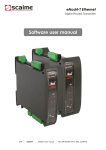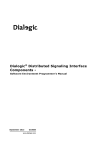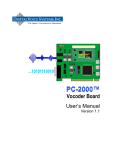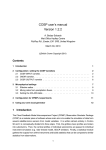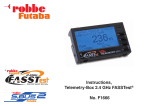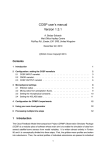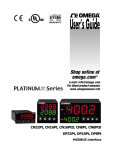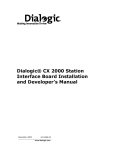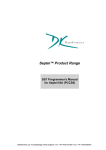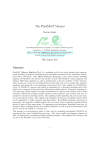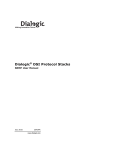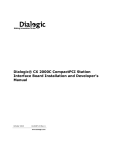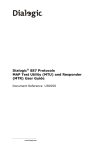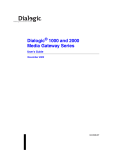Download Issue 4 - Dialogic
Transcript
Dialogic ® DSI Diameter Stack DMR Programmer's Manual September 2013 www.dialogic.com Section 1 Introduction Copyright and Legal Notice Copyright © 2012-2013 Dialogic Inc. All Rights Reserved. You may not reproduce this document in whole or in part without permission in writing from Dialogic Inc. at the address provided below. All contents of this document are furnished for informational use only and are subject to change without notice and do not represent a commitment on the part of Dialogic Inc. and its affiliates or subsidiaries (“Dialogic”). Reasonable effort is made to ensure the accuracy of the information contained in the document. However, Dialogic does not warrant the accuracy of this information and cannot accept responsibility for errors, inaccuracies or omissions that may be contained in this document. INFORMATION IN THIS DOCUMENT IS PROVIDED IN CONNECTION WITH DIALOGIC® PRODUCTS. NO LICENSE, EXPRESS OR IMPLIED, BY ESTOPPEL OR OTHERWISE, TO ANY INTELLECTUAL PROPERTY RIGHTS IS GRANTED BY THIS DOCUMENT. EXCEPT AS PROVIDED IN A SIGNED AGREEMENT BETWEEN YOU AND DIALOGIC, DIALOGIC ASSUMES NO LIABILITY WHATSOEVER, AND DIALOGIC DISCLAIMS ANY EXPRESS OR IMPLIED WARRANTY, RELATING TO SALE AND/OR USE OF DIALOGIC PRODUCTS INCLUDING LIABILITY OR WARRANTIES RELATING TO FITNESS FOR A PARTICULAR PURPOSE, MERCHANTABILITY, OR INFRINGEMENT OF ANY INTELLECTUAL PROPERTY RIGHT OF A THIRD PARTY. Dialogic products are not intended for use in certain safety-affecting situations. Please see http://www.dialogic.com/company/terms-of-use.aspx for more details. Due to differing national regulations and approval requirements, certain Dialogic products may be suitable for use only in specific countries, and thus may not function properly in other countries. You are responsible for ensuring that your use of such products occurs only in the countries where such use is suitable. For information on specific products, contact Dialogic Inc. at the address indicated below or on the web at www.dialogic.com. It is possible that the use or implementation of any one of the concepts, applications, or ideas described in this document, in marketing collateral produced by or on web pages maintained by Dialogic may infringe one or more patents or other intellectual property rights owned by third parties. Dialogic does not provide any intellectual property licenses with the sale of Dialogic products other than a license to use such product in accordance with intellectual property owned or validly licensed by Dialogic and no such licenses are provided except pursuant to a signed agreement with Dialogic. More detailed information about such intellectual property is available from Dialogic’s legal department at 1504 McCarthy Boulevard, Milpitas, CA 95035-7405 USA. Dialogic encourages all users of its products to procure all necessary intellectual property licenses required to implement any concepts or applications and does not condone or encourage any intellectual property infringement and disclaims any responsibility related thereto. These intellectual property licenses may differ from country to country and it is the responsibility of those who develop the concepts or applications to be aware of and comply with different national license requirements. Dialogic, Dialogic Pro, Dialogic Blue, Veraz, Brooktrout, Diva, Diva ISDN, Making Innovation Thrive, Video is the New Voice, VisionVideo, Diastar, Cantata, TruFax, SwitchKit, SnowShore, Eicon, Eiconcard, NMS Communications, NMS (stylized), SIPcontrol, Exnet, EXS, Vision, PowerMedia, PacketMedia, BorderNet, inCloud9, I-Gate, ControlSwitch, NaturalAccess, NaturalCallControl, NaturalConference, NaturalFax and Shiva, among others as well as related logos, are either registered trademarks or trademarks of Dialogic Inc. and its affiliates or subsidiaries. Dialogic's trademarks may be used publicly only with permission from Dialogic. Such permission may only be granted by Dialogic’s legal department at 1504 McCarthy Boulevard, Milpitas, CA 95035-7405 USA. Any authorized use of Dialogic's trademarks will be subject to full respect of the trademark guidelines published by Dialogic from time to time and any use of Dialogic’s trademarks requires proper acknowledgement. The names of actual companies and products mentioned herein are the trademarks of their respective owners. This document discusses one or more open source products, systems and/or releases. Dialogic is not responsible for your decision to use open source in connection with Dialogic products (including without limitation those referred to herein), nor is Dialogic responsible for any present or future effects such usage might have, including without limitation effects on your products, your business, or your intellectual property rights. Publication Date: September 2013 Document Reference: U01DMR 2 Dialogic® DSI Diameter Stack –DMR Programmer’s Manual Issue 4 Revision History Issue Date Description 4 30-Sep-13 Addition of resource removal message definitions 3 22-Feb-13 Multiple updates including addition of new Notify Reason & Abort Reason parameter values. 2 04-Jan-13 Additional primitive types added to DMR Session Indications and Requests Additional statistics supported. 1 31-Oct-12 Note: Initial Release for use during Dialogic® DSI Diameter Stack beta trial. The current version of this guide can be found at: http://www.dialogic.com/support/helpweb/signaling 3 Section 1 Introduction Contents Revision History............................................................................................................ 3 1 Introduction ........................................................................................................ 6 1.1 1.2 Applicability ........................................................................................................................... 6 Related Documentation ........................................................................................................... 6 2 General Description ............................................................................................. 7 2.1 2.2 2.3 2.4 2.5 2.6 2.7 2.8 2.9 Feature Overview ................................................................................................................... 7 Module interfaces ................................................................................................................... 7 Functional API ........................................................................................................................ 9 Configuration ......................................................................................................................... 9 Message Tracing ..................................................................................................................... 9 Measurements ........................................................................................................................ 9 Event Reporting...................................................................................................................... 9 User Action .......................................................................................................................... 10 Policy Based Routing ............................................................................................................. 10 3 Configuration Model .......................................................................................... 14 3.1 3.2 3.3 Module Configuration ............................................................................................................ 14 System Configuration ............................................................................................................ 15 Configuration Sequence ......................................................................................................... 15 4 Message Reference ............................................................................................ 17 4.1 4.2 Message Type Summary ........................................................................................................ 17 User Interface Messages ........................................................................................................ 18 4.2.1 Session Control Primitives - Parameter Area ................................................................ 19 4.2.2 Session Control Primitives - Primitive Type .................................................................. 20 4.2.3 Session Control Primitives - Parameters ...................................................................... 21 4.2.4 DMR_MSG_SESSION_REQ – Diameter Session Request ................................................ 23 4.2.5 DMR_MSG_SESSION_IND – Diameter Session Indication .............................................. 25 Configuration Messages ......................................................................................................... 27 4.3.1 Configuration Parameter Format................................................................................. 28 4.3.2 Configuration Parameter Definitions ............................................................................ 29 4.3.3 DMR_MSG_CONFIG - Diameter Configuration Message ................................................. 30 4.3.4 DMR_MSG_NC_CFG – Diameter NC Configuration......................................................... 33 4.3.5 DMR_MSG_APP_CFG – Diameter Application Configuration ............................................ 35 4.3.6 DMR_MSG_PEER_CFG – Diameter Peer Configuration ................................................... 37 4.3.7 DMR_MSG_ROUTE_CFG – Diameter Route Configuration ............................................... 39 4.3.8 DMR_MSG_ROUTE_LIST_CFG – Diameter Route List Configuration ................................. 42 4.3.9 DMR_MSG_APP_REM – Remove Diameter Application Configuration ............................... 44 4.3.10 DMR_MSG_PEER_REM – Remove Diameter Peer Configuration ....................................... 45 4.3.11 DMR_MSG_ROUTE_REM – Remove a Diameter Route Configuration ................................ 46 4.3.12 DMR_MSG_ROUTE_LIST_REM – Remove a Diameter Route List Configuration .................. 47 4.3.13 DMR_MSG_NC_REM – Remove Diameter Network Context Configuration......................... 48 Management Request Messages ............................................................................................. 49 4.4.1 DMR_MSG_PEER_ACTIVATE – Diameter Peer Activate Request ...................................... 50 4.4.2 DMR_MSG_PEER_DEACTIVATE – Diameter Peer Deactivate Request ............................... 51 4.4.3 DMR_MSG_S_TRACE_MASK – Set Diameter Trace Masks .............................................. 52 4.4.4 DMR_MSG_R_NC_STATS – Diameter NC Statistics ....................................................... 55 4.4.5 DMR_MSG_R_PEER_STATE – Read Peer State Request ................................................. 57 4.4.6 DMR_MSG_R_PEER_STATS – Diameter Peer Statistics .................................................. 58 4.4.7 DMR_MSG_R_APP_STATS – Diameter Application Statistics ........................................... 60 4.4.8 DMR_MSG_R_ROUTE_STATS – Diameter Route Statistics .............................................. 62 4.4.9 DMR_MSG_R_RL_STATS – Diameter Route List Statistics .............................................. 64 4.3 4.4 4 Dialogic® DSI Diameter Stack –DMR Programmer’s Manual Issue 4 4.5 Event Indication Messages ..................................................................................................... 65 4.5.1 DMR_MSG_EVENT_IND – Diameter Event Indication ..................................................... 66 4.5.2 DMR_MSG_ERROR_IND – Diameter Error Indication ..................................................... 70 4.5.3 DMR_MSG_PEER_STATE_IND - Peer Connection State Indication ................................... 72 5 External Message Definitions ............................................................................ 74 Figures Figure Figure Figure Figure 1. Dialogic® DSI Diameter Stack – DMR Context Diagram ............................................................ 8 2: Route Table Structure ........................................................................................................ 11 3: Example route configuration ............................................................................................... 12 4: Route Selection Flow ......................................................................................................... 13 5 Section 1 Introduction 1 Introduction The Dialogic® DSI Diameter Stack is a software implementation of the IETF Diameter Base Protocol which is intended to facilitate development of user applications that interface to LTE and IMS networks for the implementation of services in the areas of: Mobility, Online Charging and Offline Charging. The Dialogic® DSI Diameter Stack includes a message based binary Diameter Module, a Functional API Library and utility components and header files for use when developing a User Application. Dialogic’s Diameter Module (DMR) implements the Diameter Base Protocol offering a message based API to the User Application to control Diameter sessions. DMR is a member of the family of Dialogic® DSI Components and offers similar message-based interfaces and management capabilities to those offered for other SS7 and SIGTRAN protocol layers. DMR uses the services provided by the SCTP layer of the Dialogic® DSI SIGTRAN Stack for the transfer of messages between Diameter Peers. Dialogic’s Diameter Functional API is an API layer for use by the User Application allowing easy development of Diameter applications without being encumbered with complex encoding and decoding rules. DMR is an event driven task that uses standard structured message types for communication with other layers of the protocol stack. These messages are used to convey the protocol primitives between DMR and the User application and between DMR and SCTP. This manual provides details of the interface to DMR. It is intended for use during Configuration, Operation and Maintenance of systems that use the DSI Diameter Stack. Application Developers should refer instead to the Diameter Functional API Manual. 1.1 Applicability This manual is applicable to the following software: Dialogic® DSI Development Package for Solaris – Release 5.4.0 or later Dialogic® DSI Development Package for Linux – Release 6.6.1 or later 1.2 Related Documentation Current software and documentation supporting Dialogic® DSI components is available at: http://www.dialogic.com/support/helpweb/signaling The following User Documentation relates to the use of the Dialogic® DSI Diameter Stack: 6 Dialogic® DSI Diameter Stack - Diameter Functional API Manual Dialogic® DSI Components - Software Environment Programmer’s Manual Dialogic® DSI SIGTRAN Stack - SCTP Programmer’s Manual Dialogic® DSI Diameter Stack –DMR Programmer’s Manual Issue 4 2 2.1 General Description Feature Overview Features of the Dialogic® DSI Diameter Stack include: 2.2 Implementation of Diameter Peer State Machine Transaction buffering and failover functionality Implementation of Session State Machines Implementation of Realm Routing Table Operation as Client or Server Functional API offering full encode/decode of messages Customizable API supporting interface extension and modification User loadable Diameter definition dictionaries Module interfaces The following figure (Figure 1) shows a Context Diagram for the Dialogic® DSI Diameter Stack - Diameter Module (DMR) showing the external interfaces to the module. Each interface is message based and connects to one of the following entities: Diameter User Typically using the Dialogic® DSI Diameter Stack Functional API libraries which provide access to the user module to allow it to send and receive the Diameter primitive messages. Management The module is configured using messages. Messages are also used to send indications of relevant events to the configured management module so they can be handled or logged. Timer The module derives timing signals from the timer module supplied as part of the Dialogic® DSI Development Package. SCTP The Dialogic® DSI SIGTRAN Stack SCTPN modules provide a message based interface and access to an SCTP network for message transport. This is the interface over which the Diameter payload messages are sent or received encoded as SCTP messages. 7 Section 2 General Description User DMR_MSG_SESSION_IND DMR_MSG_SESSION_REQ DMR_MSG_CONFIG DMR_MSG_NC_CFG DMR_MSG_APP_CFG DMR_MSG_PEER_CFG DMR_MSG_ROUTE_CFG DMR_MSG_ROUTE_LIST_CFG DMR_MSG_NC_REM DMR_MSG_APP_REM DMR_MSG_PEER_REM DMR_MSG_ROUTE_REM DMR_MSG_ROUTE_LIST_REM DMR_MSG_S_TRACE_MASK DMR_MSG_PEER_ACTIVATE DMR_MSG_PEER_DEACTIVATE DMR_MSG_R_NC_STATS DMR_MSG_R_PEER_STATS DMR_MSG_R_APP_STATS DMR_MSG_R_ROUTE_STATS DMR_MSG_R_RL_STATS DMR_MSG_R_PEER_STATE DMR_MSG_R_MOD_STATS GEN_MSG_MOD_IDENT Management TIM_MSG_REGISTER Diameter TICK TIM_MSG_TICK DMR_MSG_EVENT_IND DMR_MSG_ERROR_IND DMR_MSG_PEER_STATE_IND MNG_EVT_TRACE_IND MNG_EVT_SELTRACE_IND SCTP_MSG_RX_IND SCTP_MSG_STATUS_CHANGE SCTP_MSG_NETWORK_STATUS SCTP_MSG_CONG_STATUS SCTP_MSG_RX_IND SCTP_MSG_STATUS_CHANGE SCTP_MSG_NETWORK_STATUS SCTP_MSG_CONG_STATUS SCTP Figure 1. Dialogic® DSI Diameter Stack – DMR Context Diagram 8 Dialogic® DSI Diameter Stack –DMR Programmer’s Manual Issue 4 2.3 Functional API The Dialogic® DSI Diameter Stack is supplied with a supporting Diameter Functional API interface. This interface provides a mechanism to access all aspects of the message based interface exposed by the Diameter Module and is described further in the Dialogic® DSI Diameter Stack - Diameter Functional API Manual 2.4 Configuration DMR is configured using messages which define the module set-up, including configuration and management settings to be used. The configuration model is discussed in further detail in section 3 and the messages used for configuration are defined in section 4.3. In most cases the user will not directly configure the module via these messages but will use the s7_mgt utility supplied in the DSI development package. It is also possible for the user application to generate the configuration messages directly. 2.5 Message Tracing DMR provides tracing functionality to permit copies of messages sent or received by the module to be sent to a configurable trace module. This readily permits analysis and diagnosis of systems. The module can selectively trace different interfaces and message primitive types. Further details of the message used to control the tracing can be found in section 4.4.3 2.6 Measurements DMR supports a message based statistics gathering mechanism. A user application can send a message into the module for a configured Diameter Network context and the reply to the message will be populated with the relevant statistics such as session and transaction counts. 2.7 Event Reporting DMR generates message based event and error indications to the configured management module for or logging protocol or operational events that have occurred. Events generated include: Session Handling Event Indications Indications of errors detected during processing of messages Peer state changes See section 4.5 Event Indication Messages for further details. 9 Section 2 General Description 2.8 User Action The Diameter protocol requires careful interpretation of answer messages in conjunction with runtime and configuration parameters such as DirectDebitFailureHandling or CreditControlFailureHandling to determine the correct action required by the Diameter Client. To aid compliance, interoperability and to ease application development the DMR module has been implemented to perform this interpretation for the client where appropriate. The client may then determine the required action by looking at the User Action parameter in the DMR_SESSION_IND message. This is defined in Section 4.2.3. The User Action parameter is used in Credit Control applications (including the 3GPP Ro Online Charging interface) to indicate when service should be Granted or Denied, when messages should be Stored or Deleted and when a service error indication has occurred. It is used in Base Accounting applications (including the 3GPP Rf Offline Charging interface) to indicate when messages should be Stored or Deleted. 2.9 Policy Based Routing DMR routing procedures use a routing table which is configured at system start time and used at run time. Route configuration and selection is made based on Diameter-Host or Diameter-Realm and Application-Id as per the Diameter specifications. The Diameter module extends this functionality to offer greater routing control to the User application by allowing messages for a particular destination to be routed differently under the run time control of the user. For instance, the user application may wish to route all messages for a particular set of subscribers, or a particular command code via a different relay node for special processing. Or while testing a new feature certain messages may require routing via a test system. This is achieved by the use of the optional ‘policy_id’ parameter when both configuring a route and sending DMR_SESSION_REQ messages. DMR maintains routing tables which contain the configured routing rules. All entries within a routing table must be distinct such that it is deterministic which route will be selected for a given Destination-Host, Destination-Realm and Application-Id. The policy_id allows the creation of multiple routing tables for the same Diameter Node. If a route configuration message has the policy_id parameter included, then the route will be considered part of that specific routing table. When a message is received by DSI Diameter for routing, if the policy_id is present then route selection will first search the corresponding route table. 10 Dialogic® DSI Diameter Stack –DMR Programmer’s Manual Issue 4 Route Tables Route Table Route Route Route Route Key Route Key Host Destination Route Key Destination Host Destination Realm Destination Host Destination RealmID Application Destination Realm Application ID Application ID Route Table Route Table ID RoutePolicy Table Policy ID Policy ID Route Route Route Route Route Route Route Route Route Route Key Route Route Key Key Host Destination Route Route Route Key Key Key Host Destination Destination Host Route Route Key Key Destination Realm Destination Destination Destination Host Host Host Route Key Host Destination Destination Realm Realm Destination Destination Host Application ID Destination Destination Destination Realm Realm RealmID Destination Host Application Application ID Destination Destination Realm RealmID Application Application Application ID ID Destination Realm Application Application ID ID Application ID Figure 2: Route Table Structure For example, if an application needs to route messages with Destination Realm ‘Jupiter.com’ via ‘Peer Alpha’ but wishes to route messages for certain subscribers via ‘Peer Beta’ in preference then this may be configured as follows: 1) The user configures Peer 0 (Peer Alpha) 2) The user configures Peer 1 (Peer Beta) 3) The user configures Route 0 with Destination Realm = ‘Jupiter.com’. This route has no policy_id. 4) The user configures Route List 0 mapping Route 0 with Peer A 5) The user configures Route 1 with Destination Relam = ‘Jupiter.com’ and Policy_id = 1. 6) The user configures Route List 1 mapping Route 1 with Peer B (this will take the role of primary) 7) The user configures Route List 2 mapping Route 1 with Peer A (this will take the role of secondary) This results in the configuration shown below. 11 Section 2 General Description Route 0 Route 1 Realm = Jupiter.com Realm = Jupiter.com Route List 0 Route List 2 Route List 1 Peer 0 Peer 1 Alpha Beta Figure 3: Example route configuration At run time, the user application will determine which messages require special routing and will include the policy_id parameter set to the value 1. If the Destination-Realm equals ‘Jupiter.com’, then DMR will match and select Route 1 and, presuming it is available, Peer Beta. 12 Dialogic® DSI Diameter Stack –DMR Programmer’s Manual Issue 4 The general flow through route selection logic is shown below. Route Selection DMR_SESSION_REQ Does request include Policy_ID? Yes No Select Correct Normal Routing Table Select Correct Policy ID Routing Table No Return No Route Error Search for route based on Host, Realm, Application Search for route based on Host, Realm, Application Was Route Found? Was Route Found? Yes Yes Return Found Route Return Found Route Figure 4: Route Selection Flow Note: Route Configuration and Selection operates independently for different Network Contexts. 13 Section 3 Configuration Model 3 3.1 Configuration Model Module Configuration Diameter Module Diameter Node Realm Route Route List Realm Route Route List Peer Connection Route List Diameter Application Diameter Application Peer Connection The module configuration consists of the following principal elements: Diameter Module: The DSI Diameter Module (DMR) receives configuration to control run time resource allocation and configure communication with supporting modules. Diameter Node: The module may simultaneously support several Diameter Nodes each of which is independently visible in the Diameter network(s). Each node has its own User-Name, Origin-Realm, Origin-Host and Peer Connections. Diameter Application: Each Diameter Node optionally supports a number of Diameter Applications for which it can receive traffic. These will be advertised during Capabilities Exchange. Peer Connection: A Peer connection encompasses the SCTP transport connection to a remote Peer and has a Peer State Machine instance supporting Capability exchange, Watchdog, Transaction buffering etc. Realm Route: A Realm Route defines a set of Diameter Messages for routing purposes. The set is identified based on parameters including DestinationRealm, Destination-Host and Application ID. A realm route may have a number of Route Lists. 14 Dialogic® DSI Diameter Stack –DMR Programmer’s Manual Issue 4 Route List: This identifies a Peer Connection to which messages belonging to a Realm Route may be forwarded. 3.2 System Configuration The DSI Diameter Module can be configured as part of a complete signaling system using the s7_mgt utility supplied as part of the Dialogic DSI Development Package. This utility can generate the required configuration messages from an appropriate configuration file. See Dialogic® DSI Components – Software Environment Programmer’s Manual for further details on the s7_mgt utility and the configuration syntax used. 3.3 Configuration Sequence The following is the recommend configuration sequence for the module. 1. Configure the main module settings. This will configure the module and define the module ids for the interfaces it will use to communicate with other parts of the system. It also allows module wide settings to be selected. (See DMR_MSG_CONFIG - Diameter Configuration Message. The message is generated by s7_mgt if the command SNSLI defines one or more Diameter associations). 2. Configure one or more Network Contexts. At least one of these is required and additional Network Contexts are required to connect to each distinct network. It defines settings that are specific to an individual network. (See DMR_MSG_NC_CFG - Diameter NC Configuration. The equivalent s7_mgt command is DMNCI as defined in the Software Environment Programmer’s Manual). 3. Configure each local application Defines the local application to be supported for the purposes of capability negotiation. Also defines the mapping between the wellknown AVP values for applications and a local application identifier. (See DMR_MSG_APP_CFG - Diameter Application Configuration. The equivalent s7_mgt command is DMAPI as defined in the Software Environment Programmer’s Manual). 4. Configure one or more Peer Connections Defines a remote peer connection entity within a previously configured Network Context. (See DMR_MSG_PEER_CFG - Diameter Peer Configuration. The equivalent s7_mgt command is DMPRI as defined in the Software Environment Programmer’s Manual). 5. Configure one or more Routes Defines the destination host and destination realm and links them to a Realm route. 15 Section 3 Configuration Model (See DMR_MSG_ROUTE_CFG - Diameter Route Configuration. The equivalent s7_mgt command is DMRTI as defined in Software Environment Programmer’s Manual). 6. Configure one or more Route Lists Uses previously configured Realm Routes and Peer Connections. (See DMR_MSG_ROUTE_LIST_CFG - Diameter Route List Configuration. The equivalent s7_mgt command is DMRLI as defined in the Software Environment Programmer’s Manual). 16 Dialogic® DSI Diameter Stack –DMR Programmer’s Manual Issue 4 4 4.1 Message Reference Message Type Summary The following table lists, by message type, the messages described in this manual. Message Type Mnemonic Description 0x0465 DMR_MSG_EVENT_IND Diameter Event Indication 0x0466 DMR_MSG_ERROR_IND Diameter Error Indication 0x0468 DMR_MSG_PEER_STATE_IND Peer Connection State Indication 0x6467 DMR_MSG_S_TRACE_MASK Set Diameter Trace Masks 0x6470 DMR_MSG_R_PEER_STATE Read Peer State Request 0x646e DMR_MSG_R_NC_STATS Diameter NC Statistics 0x6473 DMR_MSG_R_PEER_STATS Diameter Peer Statistics 0x6474 DMR_MSG_R_APP_STATS Diameter Application Statistics 0x6475 DMR_MSG_R_ROUTE_STATS Diameter Route Statistics 0x6476 DMR_MSG_R_RL_STATS Diameter Route List Statistics 0x7460 DMR_MSG_CONFIG Diameter Configuration Message 0x7461 DMR_MSG_NC_CFG Diameter NC Configuration 0x7462 DMR_MSG_APP_CFG Application Configuration 0x7463 DMR_MSG_PEER_CFG Diameter Peer Configuration 0x7464 DMR_MSG_ROUTE_CFG Diameter Route Configuration 0x746f DMR_MSG_ROUTE_LIST_CFG Diameter Route List Configuration 0x7469 DMR_MSG_PEER_ACTIVATE Diameter Peer Activate Request 0x746a DMR_MSG_PEER_DEACTIVATE Diameter Peer Deactivate Request 0x846d DMR_MSG_SESSION_IND Diameter Session Indication 0xc46c DMR_MSG_SESSION_REQ Diameter Session Request 0x7477 DMR_MSG_APP_REM Diameter Application Removal 0x7478 DMR_MSG_PEER_REM Diameter Peer Removal 0x7479 DMR_MSG_ROUTE_REM Diameter Route Removal 0x747a DMR_MSG_ROUTE_LIST_REM Diameter Route List Removal 0x747b DMR_MSG_NC_REM Diameter Network Context Removal 17 Section 4 Message Reference 4.2 User Interface Messages Payload messages between DMR and the User Application are all exchanges in one of two message types – a Session Request which is generated by the Application and sent to DMR and a Session Indication which is sent from DMR to the Application. Typically the user does not deal directly with these messages at the raw message level but makes use of the Diameter Functional API to create a correctly formatted message or recover the parameters from a message. Details of the Functional API for the Dialogic® DSI Diameter Stack is given in the Diameter Functional API User Manual. This section describes the raw message format used on the interface between DMR and the User Application as follows: 18 DMR_MSG_SESSION_REQ – Diameter Session Request DMR_MSG_SESSION_IND – Diameter Session Indication Dialogic® DSI Diameter Stack –DMR Programmer’s Manual Issue 4 4.2.1 Session Control Primitives - Parameter Area The parameter area of the DMR_MSG_SESSION_REQ and DMR_MSG_SESSION_IND messages both use a Name-Length-Data structure within the parameter area to allow for variable size parameters and extensibility. The Name-Length-Data method is used by several other Dialogic® DSI Stack Layers but the scheme used for DMR is different in that it always uses two bytes for the Parameter Name, two bytes for the Parameter Length and two bytes for the terminator zero. The parameter area for each message is constructed as a single byte Primitive Name followed by a list of parameters (each in Name-Length-Data format), followed by a two byte terminator Name (set to zero) indicating that there are no further parameters. The following diagrams illustrate the parameter area coding: Primitive Type Parameter Parameter Parameter Zero Each parameter is formatted as follows: Name Length Data 2 byte 2 byte ‘Parameter length’ bytes 19 Section 4 Message Reference 4.2.2 Session Control Primitives - Primitive Type The coding of the Primitive Type octet uses in the Session Control Primitives is shown in the following table: Primitive Mnemonic Value DMR-OPEN DMRSR_OPEN 1 DMR-CONTINUE DMRSR_CONTIINUE 2 DMR-CLOSE DMRSR_CLOSE 3 DMR-P-ABORT DMRSR_P_ABORT 4 DMR-NOTIFY DMRSR_NOTIFY 5 A typical User Initiated session will begin with Session Request containing an Open Primitive, which includes the Diameter Command. In the simplest case this will be ended by the reception of a Session Indication containing a Close Primitive which includes Answer to the Diameter Command. If the Diameter module detects a failure case not initiated by the Peer then a Session Indication containing P-Abort is generated. 20 Dialogic® DSI Diameter Stack –DMR Programmer’s Manual Issue 4 4.2.3 Session Control Primitives - Parameters The following parameter names are defined for use in session primitive messages: Parameter Mnemonic Value (dec) Network context DMRPN_nc 1 Diameter message DMRPN_dmtr_msg 2 Provider reason DMRPN_prov_rsn 3 Routing policy key DMRPN_routing_policy_key 4 Notify reason DMRPN_notify_rsn 5 User Action DMRPN_user_action 6 Storage message DMRPN_storage_msg 7 The coding for each parameter type is given in the following tables: Parameter name DMRPN_nc Parameter length Fixed, set to 2 Parameter data Network Context Identifier. Defaults to zero if not supplied. Parameter name DMRPN_dmtr_msg Parameter length Variable. There is no specific max size of this parameter but the complete message containing this parameter must fit within the 4200 octet message structure. Parameter data A well-formed Diameter Message encoded compliant to RFC3588 starting with the Diameter Command Header and including all AVPs. Parameter name DMRPN_prov_rsn Parameter length Fixed, set to 2 Parameter data Provider abort reason. Set to one of the following values. DMRPA_REQUEST_TIME_OUT = 1, DMRPA_GUARD_TIMER_TIMEOUT = 2, DMRPA_UNKNOWN_SSN = 3, DMRPA_FORMAT_ERR = 4, DMRPA_INVALID_REQ = 5, DMRPA_INVALID_COMMAND = 6, DMRPA_ROUTE_UNKNOWN = 7, DMRPA_ROUTE_UNAVAILABLE = 8, DMRPA_RESOURCE_UNAVAILABLE = 9, DMRPA_FAILURE_TO_SEND = 10 21 Section 4 Message Reference Parameter name DMRPN_routing_policy_key Parameter length Fixed, set to 2 Parameter data The policy identifier to be used to route the Diameter message. See section 2.9 Policy Based Routing. Parameter name DMRPN_notify_rsn Parameter length Fixed, set to 2 Parameter data Reason for notice generation. DMRNR_FORMAT_ERR = 1, DMRNR_BAD_NC = 2, DMRNR_INVALID_REQ = 3, DMRNR_MISSING_PARAM = 4, DMRNR_COMMAND_PRS_ERR = 5, DMRNR_MISSING_AVP = 6, DMRNR_PENDING_RSP = 7, DMRNR_REQUEST_TIME_OUT = 8, DMRNR_FAILURE_TO_SEND = 9 Parameter name DMRPN_user_action Parameter length Fixed, set to 4 Parameter data User Action bit field. DMRUA_FLAGS_GRANT = 0x00000001 DMRUA_FLAGS_DENY = 0x00000002 DMRUA_FLAGS_STORE = 0x00000004 DMRUA_FLAGS_SVC_ERROR = 0x00000008 DMRUA_FLAGS_UNKNOWN = 0x00000010 DMRUA_FLAGS_DELETE = 0x00000020 Parameter name DMRPN_storage_msg Parameter length Variable. There is no specific max size of this parameter but the complete message containing this parameter must fit within the 4200 octet message structure. Parameter data For Session Requests this parameter is used in place of the DMRPN_dmtr_msg parameter to indicate a message that had previously been stored and should now be resent, For Session Indications this parameter may be present to indicate a message that should be stored by the user application for later resending. This parameter takes the same format as the DMRPN_dmtr_msg parameter and therefore is also a well-formed Diameter Message encoded compliant to RFC3588 starting with the Diameter Command Header and including all AVPs. 22 Dialogic® DSI Diameter Stack –DMR Programmer’s Manual Issue 4 4.2.4 DMR_MSG_SESSION_REQ – Diameter Session Request Synopsis Message sent to the DMR module containing a Session Request Primitive. Format Message Header Field Name Meaning type DMR_MSG_SESSION_REQ (0xc46c) id session ID src user application module id dst DMR_TASK_ID rsp_req 0 hclass 0 status 0 err_info 0 len Number of bytes of user data Parameter Area Offset Size Name 0 1 Session primitive type octet. 1 Len - 3 Parameters in Name-Length-Data format. Len-2 2 Set to zero to indicate end of message. Description This message is used by the User module to send session primitives to DMR. All session primitives contain a Session ID, which is encoded in the message header. The Session ID is established by the module that generates the Open Primitive and used in all subsequent Session Primitives. For an outgoing Session, the Diameter User is responsible for generating a Session ID. For an incoming Session DMR assigns the Session ID. The following request primitive types are supported: Open Used to open a session.The request will also typically include a Diameter Command Request specified in the Diameter Message parameter (DMRPN_dmtr_msg). If the command was previously stored and now needs to be resent, then then command should be specified in the Storage Massage parameter (DMRPN_storage_msg). Continue 23 Section 4 Message Reference Used to request a session is maintained and also send either a Diameter Command Request or Answer. Close Used to request a session is closed. Typically also includes a Diameter Command Answer. Parameter area contents: The following table lists the parameters associates with each session request primitive and shows whether the parameter is Mandatory (M), in which case the message will be discarded is the parameter is omitted, or Optional (O), in which case the parameter is not considered essential. Open (1) (Diameter Message) Open (1) (Storage Message) Continue (2) Close (3) Primitive Network Context O O - - Diameter Message M - M O Routing Policy Key O O - - Storage Message - M O - Parameter 24 Dialogic® DSI Diameter Stack –DMR Programmer’s Manual Issue 4 4.2.5 DMR_MSG_SESSION_IND – Diameter Session Indication Synopsis Message sent issued by DMR to the DMR-User containing a session indication primitive. Format Message Header Field Name Meaning type DMR_MSG_SESSION_IND (0x846d) id session id src DMR_TASK_ID dst User application module id rsp_req 0 hclass 0 status 0 err_info 0 len Number of bytes of user data Parameter Area Offset Size Name 0 1 Session primitive type octet. 1 Len -3 Parameters in Name-Length-Data format. Len -2 2 Set to zero indicating end of message. Description This message is used by the DMR to send session primitives to the DMR-User. All session primitives contain the Session ID of the session to which they belong. It is encoded in the message header. The following indication primitive types are supported: Open Used to indicate a session has been opened. Typically the indication also includes a Diameter Command Request. Continue Used to indicate a session is still open and also includes either a Diameter Command Request or Answer. Close Used to request a session is closed. Typically also includes a Diameter Command Answer. P_Abort 25 Section 4 Message Reference Used to indicate a session has been aborted for reason given in the Provider Reason parameter. Notify Used to notify the application of an issue with a previous Session Request indicated by the Notify Reason parameter. Parameters The following table lists the parameters associates with each session indication primitive and shows whether the parameter is Mandatory (M), in which case the message will be discarded is the parameter is omitted, or Optional (O), in which case the parameter is not considered essential. 26 P Abort (4) Notify (5) - - - O O - - O - O M - Notify Reason - - - - M User Action - O O O O Storage Message - O O O O Parameter Open (1) Close (3) Continue (2) Primitive Network Context M Diameter Message M Provider Reason Dialogic® DSI Diameter Stack –DMR Programmer’s Manual Issue 4 4.3 Configuration Messages The Diameter Module (DMR) configuration is applied at system startup through the use of the following configuration messages. Typically these messages are generated at startup time by the configuration utility s7_mgt which takes the configuration from the config.txt file. The commands used in config.txt are documented in the Software Environment Programmer’s Manual. When s7_mgt is used for configuration, the message definitions in this section are not needed by the user. The configuration must start with the DMR_MSG_CONFIG module configuration message and then one or more DMR_MSG_NC_CFG messages to configure the Diameter Node(s). Each node will then have one or more Diameter Applications registered (DMR_MSG_APP_CFG) in addition to Diameter peers and Realm Routes. The following configuration messages are documented in this section: DMR_MSG_CONFIG - Diameter Configuration Message DMR_MSG_NC_CFG – Diameter NC Configuration DMR_MSG_APP_CFG – Diameter Application Configuration DMR_MSG_PEER_CFG – Diameter Peer Configuration DMR_MSG_ROUTE_CFG – Diameter Route Configuration DMR_MSG_ROUTE_LIST_CFG – Diameter Route List Configuration DMR_MSG_APP_REM – Diameter Application Removal DMR_MSG_PEER_REM – Diameter Peer Removal DMR_MSG_ROUTE_REM – Diameter Route Removal DMR_MSG_ROUTE_LIST_REM – Diameter Route List Removal DMR_MSG_NC_REM – Diameter NC Removal 27 Section 4 Message Reference 4.3.1 Configuration Parameter Format All configuration messages for DMR use a Name-Length-Data structure within the parameter area to allow for variable size parameters and extensibility. The Name-Length-Data method is used by several other Dialogic® DSI Stack Layers but the scheme used for DMR is different in that it always uses two bytes for the Parameter Name, two bytes for the Parameter Length and two bytes for the terminator zero. The parameter area for each configuration message is constructed as a list of parameters (each in Name-Length-Data format), followed by a two byte terminator Name (set to zero) indicating that there are no further parameters. For each message the first configuration parameter contains the main fixed length configuration parameters for the message. The following diagrams illustrate the parameter area coding: Main Configuration Parameter Additional Parameter Additional Parameter Additional Parameter Each parameter is formatted as follows: 28 Name Length Data 2 byte 2 byte ‘Parameter length’ bytes Zero Dialogic® DSI Diameter Stack –DMR Programmer’s Manual Issue 4 4.3.2 Configuration Parameter Definitions Parameter Module Configuration Mnemonic DMRCN_MOD_CONFIG Value Value (decimal) (hex) 1 0x01 Type Compound parameter See section 4.3.3 for details Network context DMRCN_NC_CFG 2 0x02 Compound parameter See section 4.3.4 for details Peer Configuration DMRCN_PEER_CFG 3 0x03 Compound parameter See section 4.3.6 for details Application Configuration DMRCN_APP_CFG Route Configuration DMRCN_ROUTE_CFG 4 0x04 Compound parameter See section 4.3.7 for details 5 0x05 Compound parameter See section 4.3.7 for details Route List Configuration DMRCN_ROUTE_LIST_CFG 6 0x06 Compound parameter Origination Host DMRCN_ORIGIN_HOST 7 0x07 String Origination Realm DMRCN_ORIGIN_REALM 8 0x08 String Node Name DMRCN_NODE_NAME 9 0x09 String Peer Host DMRCN_PEER_HOST 10 0x0a String Peer Realm DMRCN_PEER_REALM 11 0x0b String Destination Host DMRCN_DEST_HOST 12 0x0c String Destination Realm DMRCN_DEST_REALM 13 0x0d String Event Information DMRCN_EVENT_INFO 14 0x0e Compound parameter See section 4.3.8 for details See section 4.5.1 for details Error Information DMRCN_ERROR_INFO 15 0x0f Compound parameter See section 4.5.2 for details Array of app ids DMRCN_APP_IDS 16 0x10 Compound parameter See section 4.5.3 for details IP Address DMRCN_IP_ADDR 17 0x11 See section 4.3.6 for details Policy Id DMRCN_POLICY_ID 18 0x12 See section 4.3.7 for details Diameter Application Id DMRCN_DMTR_APP_ID 19 0x13 See section 4.3.7 for details 29 Section 4 Message Reference 4.3.3 DMR_MSG_CONFIG - Diameter Configuration Message Synopsis Message used to configure the Diameter module (DMR) for operation. Format Message Header Field Name Meaning type DMR_MSG_CONFIG (0x7460) id 0 src Management Module Id dst DMR_TASK_ID rsp_req 0 hclass 0 status 0 err_info 0 len variable Parameter Area Offset Size Name 0 Len -2 Parameters in Name-Length-Data format. Len -2 2 Set to zero indicating end of message. Description This message is used to configure DMR for operation. It should be the first message sent to DMR and any messages received before a valid configuration message will be discarded. It should only be issued once. The message parameters relate to the environment in which DMR is operating and the various capabilities which will be required of the module. Parameters DMR_MSG_CONFIG (0x7460) Parameter Mandatory/ Default Value Optional DMRCN_MOD_CONFIG 30 M n/a Notes Dialogic® DSI Diameter Stack –DMR Programmer’s Manual Issue 4 MOD_CONFIG DMRCN_MOD_CONFIG parameter Offset Size Name 0 1 maint_id 1 1 trace_id 2 1 sctp_id 3 1 Reserved (set to zero) 4 2 max_peers 6 4 base_og_id 10 4 base_ic_id 14 4 nog_sessions 18 4 nic_sessions 22 4 max_throughput 26 4 options maint_id Maintenance module ID. This is the module to which event and error indications are sent. trace_id Trace module ID. This is the module to which any trace messages will be sent. sctp_id SCTP module ID. This is the module_id of the transport layer. max_peers The maximum number of Diameter peers that the module is required to support. This value is compared with any internal limits. base_og_id The first session ID for outgoing sessions that the user wishes to be handled by DMR. The subsequent (nog_sessions -1) session IDs will also be handled by the module. The user must ensure that the values used in the session ID field of all protocol messages pertaining to outgoing sessions lie within the correct range. base_ic_id The first session ID for incoming sessions that the user wishes to be handled by DMR. The subsequent (nic_sessions -1) session IDs will also be handled by the module. The Diameter Module allocates the session ID for each incoming session. It uses values in the range nog_sessions The maximum number of simultaneous outgoing sessions that the module is required to support. This value is compared with any internal limits. 31 Section 4 Message Reference nic_sessions The maximum number of simultaneous incoming sessions that the module is required to support. This value is compared with any internal limits. max_throughput This parameter is reserved for future use and should be set to zero. options Run-time options field, reserved for future use set to zero 32 Dialogic® DSI Diameter Stack –DMR Programmer’s Manual Issue 4 4.3.4 DMR_MSG_NC_CFG – Diameter NC Configuration Synopsis Message sent to DMR to configure a Diameter Network Context. Format Message Header Field Name Meaning Type DMR_MSG_NC_CFG (0x7461) Id nc_id Src Sending module id Dst DMR_TASK_ID rsp_req 0 Hclass 0 Status 0 err_info 0 Len variable Parameter Area Offset Size Name 0 Len -2 Parameters in Name-Length-Data format. Len -2 2 Set to zero indicating end of message. Description The message allows the configuration of independent Diameter Network Contexts. Each Network Context embodies a separate Diameter Node each of which can be independently configured allowing different behaviour and routing rules for the module. Parameters DMR_MSG_NC_CFG (0x7461) Parameter Mandatory/ Default Value Notes Optional DMRCN_NC_CFG M DMRCN_ORIGIN_HOST M DMRCN_ORIGIN_REALM M DMRCN_NODE_NAME M 33 Section 4 Message Reference NC_CFG DMRCN_NC_CFG parameter Offset 0 Size 4 Name options nc_id The logical id for this Network Context for use in communication with local management and maintenance agents. node_name The user_name value which should be used for Diameter protocol messages originated from this node. Formatted as a UTF-8 String. origin_host The origin_host value which should be used for Diameter protocol messages originated from this node. Formatted as a UTF-8 String. origin_realm The origin_realm value which should be used for Diameter protocol messages originated from this node. Formatted as a UTF-8 String. options Run-time options for this NC. None currently defined. 34 Dialogic® DSI Diameter Stack –DMR Programmer’s Manual Issue 4 4.3.5 DMR_MSG_APP_CFG – Diameter Application Configuration Synopsis Message sent to DMR to configure a Diameter Application for a particular Network Context. Format Message Header Field Name Meaning type DMR_MSG_APP_CFG (0x7462) id application_id src Sending module_id dst DMR_TASK_ID rsp_req 0 hclass 0 status 0 err_info 0 len variable Parameter Area Offset Size Name 0 Len -2 Parameters in Name-Length-Data format. Len -2 2 Set to zero indicating end of message. Description DMR allows Diameter Applications to be registered against a Network Context. Once configured Peer Connections part of the same Network Context will advertise this Application during Capabilities Exchange and messages received for the application will be forwarded to the configured User module_id. Parameters DMR_MSG_APP_CFG (0x7462) Parameter Mandatory/ Default Value Notes Optional DMRCN_APP_CFG M 35 Section 4 Message Reference APP_CFG DMRCN_APP_CFG parameter Offset Size Name 0 4 options 4 1 mod_id 5 1 reserved (Must be set to 0) 6 2 mod_inst 8 2 nc_id 10 4 vendor_id 14 4 dmtr_app_id application ID The logical id for the application used in communication with DMR concerning this application. This value is of local significance between DMR and local configuration and maintenance agents. It is distinct and separate to the wellknown ‘app_id’ value configured later in this message. options Run-time options for this application. Reserved for future use and should be set to zero. mod_id User module ID for this Application. mod_inst User Instance for this Application. This is of relevance to DMR-User applications deployed on remote RSI-Hosts. nc_id The Network Context Id this application is being registered with. vendor_id The Diameter Vendor ID AVP value for use in Diameter capability negotiation. dmtr_app_id The Diameter Application ID AVP value for use in Diameter capability negotiation. 36 Dialogic® DSI Diameter Stack –DMR Programmer’s Manual Issue 4 4.3.6 DMR_MSG_PEER_CFG – Diameter Peer Configuration Synopsis Message sent to DMR configure a Diameter Peer connection for a particular Network Context. Format Message Header Field Name Meaning Type DMR_MSG_PEER_CFG (0x7463) Id peer_id Src Sending module id Dst DMR_TASK_ID rsp_req 0 Hclass 0 Status 0 err_info 0 Len variable Parameter Area Offset Size Name 0 Len -2 Parameters in Name-Length-Data format. Len -2 2 Set to zero indicating end of message. Description The Diameter Module allows Peer Diameter nodes, with which it expects to communicate, to be statically configured. Peer nodes may be Diameter Agents, Servers or Clients and may use dynamically or statically configured transport connections. Each Peer Connection belongs to a pre-configured Network Context. Parameters DMR_MSG_PEER_CFG (0x7463) Parameter Mandatory/ Default Value Notes Optional DMRCN_PEER_CFG M DMRCN_PEER_HOST M DMRCN_PEER_REALM M DMRCN_IP_ADDR M 37 Section 4 Message Reference PEER_CFG DMRCN_PEER_CFG parameter Offset Size Name 0 4 options 4 2 nc_id 6 2 asc_id peer_id The logical id of this Peer used for control and communication of the Peer by local management and maintenance agents. options Run-time options for this Peer assigned according to the following table: Bit Mnemonic 0 DMR_PEER_OPT_SERVER Description Set if the transport connection end point acts as the Server side nc_id The logical id of a preconfigured Network Context to which this Peer belongs. asc_id The logical id of the transport connection used to communicate with this Peer. Messages sent to and received from the Transport Module (e.g. the SCTPN module) must be configured to use this logical id. host An ASCII or UTF-8 String identifying the expected host-name AVP value for this Peer. This can be used to correlate dynamically created transport connections with pre-configured Peers or to validate statically configured transport addresses advertise the expected host-name AVP value. realm An ASCII or UTF-8 String identifying the expected realm-name AVP value for this Peer. This can be used to correlate dynamically created transport connections with pre-configured Peers or to validate statically configured transport addresses advertise the expected realm-name AVP value. ip_addr The local IP addresses to be advertised to the Peer as part of the capabilities exchange. Allows up to 4 IP addresses, each 17 octets in length formatted as follows: Octet 0 38 Field Description Format Set to value 1 indicating an Ipv4 address. 1 .. 4 Network address Octet 1 containing the most significant byte and octet 4 containing the least significant byte 5 .. 17 Reserved Should be set to zero. Dialogic® DSI Diameter Stack –DMR Programmer’s Manual Issue 4 4.3.7 DMR_MSG_ROUTE_CFG – Diameter Route Configuration Synopsis Message sent to DMR to configure an entry in the Diameter Routing Table for a particular Network Context. Format Message Header Field Name Meaning Type DMR_MSG_ROUTE_CFG (0x7464) Id route_id Src Sending module id Dst DMR_TASK_ID rsp_req 0 Hclass 0 Status 0 err_info 0 Len Variable Parameter Area Offset Size Name 0 Len -2 Parameters in Name-Length-Data format. Len -2 2 Set to zero indicating end of message. Description The Diameter Routing table allows the configuration of routing rules for use with Diameter Messages received from the User Application. Selection of a Diameter Peer for message routing is based on network conditions and the following: 1) Peer route – Route selection is made based on a match of the Destination-Host protocol parameter 2) Realm route – Route selection is made based on a routing key match. The routing key consists of the Destination-Realm and Application-ID protocol parameters; the key also includes the user defined network context and routing policy key 3) Default route – User defined default route (per network context) The message must contain either the DMRRT_OPT_DEFAULT run-time option or one of the optional parameters, DMRCN_DEST_HOST or DMRCN_DEST_REALM. If the DMRCN_DEST_REALM parameter is present, DMRCN_DMTR_APP_ID and DMRCN_POLICY_ID may be used. 39 Section 4 Message Reference Parameters DMR_MSG_ROUTE_CFG (0x7464) Parameter Mandatory/ Default Value Notes Optional DMRCN_ROUTE_CFG M DMRCN_DEST_HOST O Peer based routing (Diameter Destination Host) DMRCN_DEST_REALM O Realm based routing (Diameter Destination Realm) DMRCN_DMTR_APP_ID O Realm based routing (Diameter ApplicationId) DMRCN_POLICY_ID O Realm based routing (User defined) ROUTE_CFG DMRCN_ROUTE_CFG parameter Offset Size Name 0 4 options 4 2 nc_id options Run-time options for this Peer assigned according to the following table: Bit Mnemonic Description 0 DMRRT_OPT_DEFAULT Designates this route as the Default Route for this Network Context. A default route will be used if an attempt to route does not match a host-based or realm-based route. 1 DMRRT_OPT_LOAD_SHARE Load share traffic between available peer connections based on NAI value. nc_id The logical id of the Network Context for which this route applies. DMRCN_DMTR_APP_ID The Diameter Application Identifier for which this route applies. DMRCN_DMTR_APP_ID parameter Offset 0 40 Size 4 Name dmtr_app_id Dialogic® DSI Diameter Stack –DMR Programmer’s Manual Issue 4 DMRCN_POLICY_ID A user defined identifier providing a routing policy for the route. The policy id is used to distinguish routes which otherwise share common routing parameters. The value can be used in to control route selection on a permessage basis. DMRCN_POLICY_ID parameter Offset 0 Size 2 Name dmtr_app_id 41 Section 4 Message Reference 4.3.8 DMR_MSG_ROUTE_LIST_CFG – Diameter Route List Configuration Synopsis Message sent to DMR to configure a single route list entry. Each route list entry defines a mapping between a route and a peer for use in the Diameter Routing Table. Format Message Header Field Name Meaning Type DMR_MSG_ROUTE_LIST_CFG (0x746f) Id route_list_id Src Sending module id Dst DMR_TASK_ID rsp_req 0 Hclass 0 Status 0 err_info 0 Len Variable Parameter Area Offset Size Name 0 Len -2 Parameters in Name-Length-Data format. Len -2 2 Set to zero indicating end of message. Description The Diameter Routing Table allows static configuration of Route Lists which associate a peer with a route. The peer defined in the Route List is a candidate next hop destination for the route. A route may be associated with multiple peers and a peer may be associated with multiple routes. Parameters DMR_MSG_ROUTE_LIST_CFG (0x746f) Parameter Mandatory/ Optional DMRCN_ROUTE_LIST_CFG 42 M Default Value Notes Dialogic® DSI Diameter Stack –DMR Programmer’s Manual Issue 4 ROUTE_CFG DMRCN_ROUTE_LIST_CFG parameter Offset Size Name 0 4 options 4 2 route_id 6 2 peer_id options Run-time options. Reserved for future use and should be set to zero. Route_id The logical id of the route for which the peer_id will be associated peer_id The logical id of the peer which can be used as a next hop destination for the route_id. 43 Section 4 Message Reference 4.3.9 DMR_MSG_APP_REM – Remove Diameter Application Configuration Synopsis Message sent to DMR to remove a Diameter Application for a particular Network Context. Format Message Header Field Name Meaning type DMR_MSG_APP_REM (0x7477) id application_id src Sending module_id dst DMR_TASK_ID rsp_req 0 hclass 0 status 0 err_info 0 len 0 Description DMR allows Diameter Applications to be removed from a Network Context. Once removed, Peer Connections part of the same Network Context will no longer advertise this Application during Capabilities Exchange and messages received for the application will be no longer be forwarded to the user. All peers within the network context must be deactivated prior to removing an application. All routes within the network context which define a Diameter Application Id as part of its configuration must be removed before attempting to remove an application which shares the same Diameter Application Id. 44 Dialogic® DSI Diameter Stack –DMR Programmer’s Manual Issue 4 4.3.10 DMR_MSG_PEER_REM – Remove Diameter Peer Configuration Synopsis Message sent to DMR to remove a Diameter Peer connection for a particular Network Context. Format Message Header Field Name Meaning type DMR_MSG_PEER_REM (0x7478) id peer_id src Sending module id dst DMR_TASK_ID rsp_req 0 hclass 0 status 0 err_info 0 len 0 Description The Diameter Module allows Peer Diameter nodes, with which it expects to communicate, to be statically configured and removed. Peer nodes may be Diameter Agents, Servers or Clients and may use dynamically or statically configured transport connections. Each Peer Connection belongs to a preconfigured Network Context. All route list entries which reference a peer must be removed prior to removing the peer configuration. 45 Section 4 Message Reference 4.3.11 DMR_MSG_ROUTE_REM – Remove a Diameter Route Configuration Synopsis Message sent to DMR to remove an entry in the Diameter Routing Table for a particular Network Context. Format Message Header Field Name Meaning type DMR_MSG_ROUTE_REM (0x7479) id route_id src Sending module id dst DMR_TASK_ID rsp_req 0 hclass 0 status 0 err_info 0 len 0 Description The Diameter Routing table may be updated by issuing this message to remove a routing entry. Once removed, user messages will no longer be matched to this route. The next available route matching the routing parameters of the user message will be selected. All route list entries which reference a route must be removed prior to removing the route configuration. 46 Dialogic® DSI Diameter Stack –DMR Programmer’s Manual Issue 4 4.3.12 DMR_MSG_ROUTE_LIST_REM – Remove a Diameter Route List Configuration Synopsis Message sent to DMR to remove a single route list entry. Each route list entry defines a mapping between a route and a peer for use in the Diameter Routing Table. Format Message Header Field Name Meaning type DMR_MSG_ROUTE_LIST_REM (0x747a) id route_list_id src Sending module id dst DMR_TASK_ID rsp_req 0 hclass 0 sStatus 0 err_info 0 len 0 Description The Diameter Routing Table allows removal of Route List entries which associate a peer with a route. The peer defined in the Route List is a candidate next hop destination for the route. 47 Section 4 Message Reference 4.3.13 DMR_MSG_NC_REM – Remove Diameter Network Context Configuration Synopsis Message sent to DMR to remove a Diameter Network Context configuration. Format Message Header Field Name Meaning type DMR_MSG_APP_REM (0x747b) id nc_id src Sending module_id dst DMR_TASK_ID rsp_req 0 hclass 0 status 0 err_info 0 len 0 Description DMR allows Diameter Network Contexts to be removed. All resources currently configured within this network context such as Peers, Routes, Route Lists and Applications must be removed prior to removing the Network Context configuration. 48 Dialogic® DSI Diameter Stack –DMR Programmer’s Manual Issue 4 4.4 Management Request Messages This section details the format of the following management request messages that can be used to interface with DMR for control purposes or to request status. DMR_MSG_PEER_ACTIVATE – Diameter Peer Activate Request DMR_MSG_PEER_DEACTIVATE – Diameter Peer Deactivate Request DMR_MSG_S_TRACE_MASK – Set Diameter Trace Masks DMR_MSG_R_NC_STATS – Diameter NC Statistics DMR_MSG_R_PEER_STATE – Read Peer State Request DMR_MSG_R_PEER_STATS – Diameter Peer Statistics DMR_MSG_R_APP_STATS – Diameter Application Statistics DMR_MSG_R_ROUTE_STATS – Diameter Route Statistics DMR_MSG_R_RL_STATS – Diameter Route List Statistics 49 Section 4 Message Reference 4.4.1 DMR_MSG_PEER_ACTIVATE – Diameter Peer Activate Request Synopsis This primitive is used by management to request DMR to activate the connection to the identified peer. Format Message Header Field Name Meaning type DMR_MSG_PEER_ACTIVATE (0x7469) id peer_id src Sending module id dst DMR_TASK_ID rsp_req 0 hclass 0 status 0 err_info 0 len 0 Description On receipt of this message, DMR attempts to activate the specified Peer connection. Receipt of a confirmation message does not imply the connection is available for use merely that DMR is attempting to bring the connection into service. Peer availability is indicated through the DMR_MSG_PEER_STATE_IND message. The user can determine the current state of a Peer connection on demand using the DMR_MSG_R_PEER_STATUS message. 50 Dialogic® DSI Diameter Stack –DMR Programmer’s Manual Issue 4 4.4.2 DMR_MSG_PEER_DEACTIVATE – Diameter Peer Deactivate Request Synopsis This primitive is used by management to request DMR to deactivate the specified peer connection. Format Message Header Field Name Meaning type DMR_MSG_PEER_DEACTIVATE (0x746a) id peer_id src Sending module id dst DMR_TASK_ID rsp_req 0 hclass 0 status 0 err_info 0 len 0 Description On receipt of this message DMR attempts to deactivate the specified Peer connection 51 Section 4 Message Reference 4.4.3 DMR_MSG_S_TRACE_MASK – Set Diameter Trace Masks Synopsis Message used by management to set the DMR trace masks. Format Message Header Field Name Meaning type DMR_MSG_S_TRACE_MASK (0x6467) id 0 src Sending module id dst DMR_TASK_ID rsp_req 0 hclass 0 status 0 err_info 0 len 12 Parameter Area Offset Size Name 0 4 op_mask 4 4 ip_mask 8 4 mngt_mask Description The trace masks allow the user to request messages generated and received by the DMR module to be copied and traced to the trace module for diagnostic purposes. Tracing can be turned on and off dynamically on a per primitive basis. Tracing is controlled by three 32 bit masks (output, input and management) and bits set to one in the mask cause messages of that type to be traced. 52 Dialogic® DSI Diameter Stack –DMR Programmer’s Manual Issue 4 Parameters op_mask The output event trace mask. This is a 32-bit value with bits set to 1 to cause a trace message to be sent to the trace module when DMR sends the associated protocol message. Bit Message to be Traced Description 0 DMR_MSG_SESSION_IND Trace session indication primitives issued to user by DMR. 1 DMR_MSG_EVENT_IND Trace event indication issued by DMR. 2 DMR_MSG_ERROR_IND Trace error indications issued by DMR. 3 SCTP_MSG_ACTIVATE Trace SCTP activation requests issued by DMR. 4 SCTP_MSG_SHUTDOWN Trace SCTP shutdown requests issued by DMR. 5 SCTP_MSG_TX_REQ Trace SCTP transmit requests issued by DMR 7 to 31 Reserved for future use and should be set to zero. Ip_mask The input event trace mask. This is a 32-bit value with bits set to 1 to cause a trace message to be sent to the system trace module when DMR receives the associated protocol message. Bit Message to be Traced Description 0 DMR_MSG_SESSION_REQ Trace session request primitives received by DMR. 1 SCTP_MSG_RX_IND Trace SCTP receive indications received by DMR. 2 SCTP_MSG_STATUS_CHANGE Trace SCTP status messages received by DMR 3 SCTP_MSG_CONG_STATUS Trace SCTP congestion indications received by DMR. 4 to 31 Reserved for future use and should be set to zero. 53 Section 4 Message Reference mngt_mask The management event trace mask. This is a 32-bit value with bits set to 1 to cause a trace message to be sent to the system trace module when DMR receives the associated protocol message. Bit Message to be Traced 0 DMR_MSG_S_TRACE_MASK Trace any set trace mask primitives received by DMR. 1 DMR_MSG_NC_CFG Trace NC configuration messages received by DMR. 2 DMR_MSG_PEER_CFG Trace peer configuration messages received by DMR. 3 DMR_MSG_PEER_ACTIVATE Trace peer activation requests received by DMR. 4 DMR_MSG_PEER_DEACTIVATE Trace peer deactivation requests received by DMR. 5 Reserved for future use. Set to zero. 6 DMR_MSG_APP_CFG Trace application configuration messages received by DMR. 7 DMR_MSG_ROUTE_CFG Trace route configuration messages received by DMR. 8 DMR_MSG_R_NC_STATS Trace read NC stats requests received by DMR. 9 DMR_MSG_R_PEER_STATE Trace read peer state requests received by DMR. 10 11 12 to 31 54 Description Reserved for future use. Set to zero. DMR_MSG_ROUTE_LIST_CFG Trace route list configuration messages received by DMR. Reserved for future use and should be set to zero. Dialogic® DSI Diameter Stack –DMR Programmer’s Manual Issue 4 4.4.4 DMR_MSG_R_NC_STATS – Diameter NC Statistics Synopsis Message used to query measurements for a specific Diameter Network Context. Format Message Header Field Name Meaning type DMR_MSG_R_NC_STATS (0x646e) id nc_id src Sending module id dst DMR_TASK_ID rsp_req Sending layer’s bit must be set hclass 0 status 0 – Leave stats unchanged 1 – Reset stats after reading err_info 0 len 16 Parameter Area Offset Size Name 0 4 ssn_alloc_count 4 4 ssn_dealloc_count 8 4 tran_alloc_count 12 4 tran_dealloc_count Description This message allows the user to query the Network Context to determine its current usage of system resources. The counters can be reset or left unchanged depending on the setting of the status field. The user should send the message with all fields set to zero. Note: In this context a transaction is made up of a Diameter Request and a corresponding Diameter Answer. A session is made up of one or more transactions between two peer entities. Parameters ssn_alloc_count The number of session resources which have been allocated. 55 Section 4 Message Reference Ssn_dealloc_count The number of session resources which have been de-allocated. Tran_alloc_count The number of transaction resources which have been allocated. Tran_dealloc_count The number of transaction resources which have been de-allocated. 56 Dialogic® DSI Diameter Stack –DMR Programmer’s Manual Issue 4 4.4.5 DMR_MSG_R_PEER_STATE – Read Peer State Request Synopsis Message used to query the current Peer State. Format Message Header Field Name Meaning type DMR_MSG_R_PEER_STATE (0x6470) id peer_id src Sending module id dst DMR_TASK_ID rsp_req Sending layer’s bit must be set hclass 0 status 0 err_info 0 len 3 Parameter Area Offset Size Name 0 1 availability 1 2 State_flags Description This message allows the user to query the Peer State. The user should allocate a message with sufficient space in the parameter area and DMR will fill in the parameter area in the response message. Parameters availability Peer availability state. Possible values are shown in the table below: Value Mnemonic Description 0 DMR_PEER_STATE_UNKNOWN Entered Unknown State 1 DMR_PEER_STATE_CLOSED Entered CLOSED State 2 DMR_PEER_STATE_OPEN Entered OPEN State state_flags Additional state information related to the peer. Bit 0 is set to 1 if a request to activate the peer has been made. All other bits are reserved for future use and will be set to zero. 57 Section 4 Message Reference 4.4.6 DMR_MSG_R_PEER_STATS – Diameter Peer Statistics Synopsis Message used to query measurements for a specific Diameter Peer. Format Message Header Field Name Meaning type DMR_MSG_R_PEER_STATS (0x6473) id peer_id src Sending module id dst DMR_TASK_ID rsp_req Sending layer’s bit must be set hclass 0 status 0 – Leave stats unchanged 1 – Reset stats after reading err_info 0 len 32 Parameter Area Offset Size Name 0 4 Period 4 4 tx_octet 8 4 rx_octet 12 4 tx_msg 16 4 rx_msg 20 4 peer_error 24 4 closed_cnt 28 4 open_duration Description This message allows the user to query a specific peer to read measurements. The counters can be reset or left unchanged depending on the setting of the status field. The user should send the message with all fields set to zero. Parameters period Period over which the measurements have been collected (in multiples of 100ms). 58 Dialogic® DSI Diameter Stack –DMR Programmer’s Manual Issue 4 Tx_octet Number of octets transmitted. Rx_octet Number of octets received. Tx_msg Number of messages transmitted. Rx_msg Number of messages received. Peer_error Number of errors associated with this peer including peer timeouts, unexpected messages and remote disconnections. Closed_cnt Count of state transitions to the CLOSED state. Open_duration Duration within period the Peer has been in the OPEN state (in multiples of 100ms). 59 Section 4 Message Reference 4.4.7 DMR_MSG_R_APP_STATS – Diameter Application Statistics Synopsis Message used to query measurements for a specific Diameter Application. Format Message Header Field Name Meaning type DMR_MSG_R_APP_STATS (0x6474) id application_id src Sending module id dst DMR_TASK_ID rsp_req Sending layer’s bit must be set hclass 0 status 0 – Leave stats unchanged 1 – Reset stats after reading err_info 0 len 20 Parameter Area Offset Size Name 0 4 period 4 4 tx_octet 8 4 rx_octet 12 4 tx_msg 16 4 rx_msg Description This message allows the user to query a specific application to read measurements. The counters can be reset or left unchanged depending on the setting of the status field. The user should send the message with all fields set to zero. Parameters period Period over which the measurements have been collected (in multiples of 100ms). Tx_octet Number of octets transmitted. 60 Dialogic® DSI Diameter Stack –DMR Programmer’s Manual Issue 4 Rx_octet Number of octets received. Tx_msg Number of messages transmitted. Rx_msg Number of messages received. 61 Section 4 Message Reference 4.4.8 DMR_MSG_R_ROUTE_STATS – Diameter Route Statistics Synopsis Message used to query measurements for a specific Diameter Route. Format Message Header Field Name Meaning type DMR_MSG_R_ROUTE_STATS (0x6475) id route_id src Sending module id dst DMR_TASK_ID rsp_req Sending layer’s bit must be set hclass 0 status 0 – Leave stats unchanged 1 – Reset stats after reading err_info 0 len 16 Parameter Area Offset Size Name 0 4 period 4 4 tx_octet 8 4 tx_msg 12 4 redirect Description This message allows the user to query a specific Diameter route to read measurements. The counters can be reset or left unchanged depending on the setting of the status field. The user should send the message with all fields set to zero. Parameters period Period over which the measurements have been collected (in multiples of 100ms). Tx_octet Number of user provided octets transmitted over this route. Tx_msg Number of user provided messages transmitted over this route. 62 Dialogic® DSI Diameter Stack –DMR Programmer’s Manual Issue 4 Redirect Number of Diameter messages redirected to an alternative peer. 63 Section 4 Message Reference 4.4.9 DMR_MSG_R_RL_STATS – Diameter Route List Statistics Synopsis Message used to query measurements for a specific Diameter Route List entry. Format Message Header Field Name Meaning type DMR_MSG_R_RL_STATS (0x6476) id route_list_id src Sending module id dst DMR_TASK_ID rsp_req Sending layer’s bit must be set hclass 0 status 0 – Leave stats unchanged 1 – Reset stats after reading err_info 0 len 12 Parameter Area Offset Size Name 0 4 period 4 4 down_count 8 4 up_duration Description This message allows the user to query a specific Diameter Route List entry to read measurements. The counters can be reset or left unchanged depending on the setting of the status field. The user should send the message with all fields set to zero. Parameters period Period over which the measurements have been collected (in multiples of 100ms). Down_count Count of Route List state transitions to the DOWN state. Up_duration Duration within period the Route List has been in the UP state (in multiples of 100ms). 64 Dialogic® DSI Diameter Stack –DMR Programmer’s Manual Issue 4 4.5 Event Indication Messages Event indication messages are the mechanism by which protocol and software error events are reported to management. The following event indication messages generated by DMR are documented in this section: DMR_MSG_EVENT_IND – Diameter Event Indication DMR_MSG_ERROR_IND – Diameter Error Indication DMR_MSG_PEER_STATE_IND - Peer Connection State Indication 65 Section 4 Message Reference 4.5.1 DMR_MSG_EVENT_IND – Diameter Event Indication Synopsis Message sent by DMR to the management module to indicate a protocol related event has occurred. Format Message Header Field Name Meaning type DMR_MSG_EVENT_IND (0x0465) id See below src DMR_TASK_ID dst Maintenance module id rsp_req 0 hclass 0 status Event Code (see below) err_info 0 len 8 Parameter Area Offset Size Name 0 4 param1 4 4 param2 Description Message used by DMR to indicate a Diameter protocol event has occurred. Parameters Event Code The event code contained in the status field of the message indicates the type of event. Possible values are listed in the following table that also lists the meaning of the id field, param1 and param2 in each case. Unused values are set to zero. Code 66 Mnemonic Id Param1 1 DMR_EVENT_DECODE_ AVP_MISSING 0 int_status 2 DMR_EVENT_DECODE_ AVP_DOESNT_BELONG int_status 0 Param2 Description A mandatory AVP is missing from a diameter message. 0 An inappropriate AVP has been detected whilst decoding Dialogic® DSI Diameter Stack –DMR Programmer’s Manual Issue 4 Code Mnemonic Id Param1 Param2 Description 3 DMR_EVENT_DECODE_ AVP_MISFORMATTED nc_id AVP id len An AVP has been decode with an invalid format, e.g. Bad length 4 DMR_EVENT_DECODE_ AVP_ERROR nc_id AVP code bytes_proces sed A badly formatted Diameter Message has been received. Param2 indicates the offset of the error within the Diameter message 5 DMR_EVENT_DECODE_ MSG_ERROR session_id 0 0 Decoding of message detected a problem 6 DMR_EVENT_DECODE_ PEER_NAME peer_id 0 0 Could not decode Peer name as part of Capability Exchange. 7 DMR_EVENT_DECODE_ PEER_REALM peer_id 0 0 Could not decode Peer realm as part of Capability Exchange. 10 DMR_EVENT_NC_UNKN OWN 0 nc_id 11 DMR_EVENT_NC_UNKN OWN_APP_ID nc_id app_id 0 12 DMR_EVENT_NC_APP_I D 0 0 0 20 DMR_EVENT_PEER_ER ROR peer_id num_app 0 An error adding an application to a peer has occurred. 21 DMR_EVENT_PEER_RE FUSED peer_id 0 0 A dynamic connection request has been refused 22 DMR_EVENT_PEER_UN EX_REALM peer_id 0 0 The peers advertised realm name does not match that configured. 23 DMR_EVENT_PEER_UN EX_HOST peer_id 0 0 The peers advertised host name does not match that configured. 24 DMR_EVENT_PEER_UN EX_ASC_ID assoc_id 0 0 Unexpected association for peer The identified network context ID is invalid. Could not identify application based on an unknown application id. 67 Section 4 Message Reference Code 68 Mnemonic Id Param1 Param2 Description 25 DMR_EVENT_PEER_CA peer_id P_EX_NO_COMMON_AP PS 0 0 A capability exchange procedure failed due to no common applications 26 DMR_EVENT_PEER_CA peer_id P_EX_NO_COMMON_SE CURITY 0 0 A capability exchange procedure failed due to no common security 27 DMR_ERROR_PEER_CA peer_id P_EX_FAILED 0 0 A capability exchange procedure failed 28 DMR_EVENT_PEER_DP R_RXED peer_id Disconnecti on-cause AVP value 0 A DPR message has been received 29 DMR_EVENT_PEER_UN EX_APP_ID peer_id Application- 0 Id An unexpected Application-Id has been received. 30 DMR_EVENT_TRAN_RU N_OUT 0 0 0 The system failed to allocate a new transaction resource 40 DMR_EVENT_SSN_BAD _ID session_id 0 0 An event has been received for a session id which is not in use 41 DMR_EVENT_SSN_INVA session_id LID_ID 0 0 An event has been received for a session id which is invalid 42 DMR_EVENT_SSN_RUN _OUT 0 0 0 The module has run out of session resources to allocate 51 DMR_EVENT_REQ_BAD _PRIM_TYPE session_id 0 0 User request contained an unknown primitive type. 52 DMR_EVENT_REQ_MISS ING_PARAM param tag primitive type A mandatory parameter is missing from the request 53 DMR_EVENT_REQ_DMT session_id R_REQ_FLAG 0 0 The Diameter request flag is set - reset expected 54 DMR_EVENT_REQ_BAD _DMTR_MSG nc_id 0 A problem was found parsing with the request values session_id Dialogic® DSI Diameter Stack –DMR Programmer’s Manual Issue 4 Code Mnemonic Id Param1 Param2 Description 55 DMR_EVENT_REQ_BAD _APP_ID 0 nc_id application_id Session request received for an unknown and unhandled application 56 DMR_EVENT_REQ_TOO _SHORT session_id len 0 The DMR_SESSION_RE Q message was too short 57 DMR_EVENT_REQ_BAD _PARAM session_id param_tag len A problem was found parsing the request format 58 DMR_EVENT_REQ_BAD _FMT session_id 0 0 The parameter was an invalid length 59 DMR_EVENT_REQ_BAD _TERM session_id 0 0 The terminating two bytes should have value zero. 60 DMR_EVENT_REQ_UNE X_PRIM session_id 0 0 Unexpected primitive type received for the session in use. 61 DMR_EVENT_REQ_NO_ DEST_AVP session_id 0 0 Request has no host or realm specified 62 DMR_EVENT_REQ_NO_ RESULT_AVP session_id 0 0 Request has no result or experimental result code specified 63 DMR_EVENT_REQ_MISS session_id ING_AVP 0 0 A required AVP for message is missing 70 DMR_EVENT_ROUTE_U NKNOWN session_id nc_id 0 An appropriate route could not be selected 71 DMR_EVENT_ROUTE_U NAVAILABLE rte_id session_id 0 The Route selected is currently unavailable for routing. 69 Section 4 Message Reference 4.5.2 DMR_MSG_ERROR_IND – Diameter Error Indication Synopsis Message sent by DMR to the management module to indicate an exceptional or erroneous protocol event or implementation error has occurred. Format Message Header Field Name Meaning type DMR_MSG_ERROR_IND (0x0466) id See below src DMR_TASK_ID dst Maintenance module id rsp_req 0 hclass 0 status error_code (see below) err_info 0 len 8 Parameter Area Offset Size Name 0 4 param1 4 4 param2 Description This message used by DMR to convey the occurrence of an exceptional or erroneous protocol event or implementation error and to convey additional diagnostic information to facilitate investigation of the problem. Parameters error_code The error code contained in the status filed of the message indicates the type of error. Possible values are listed in the following table that also lists the meaning of the id field, param1 and param2 in each case. Unused values are set to zero. 70 Dialogic® DSI Diameter Stack –DMR Programmer’s Manual Issue 4 Code Mnemonic Id param1 param2 Description 1 DMR_ERROR_PEER_CREATIO peer_id N_FAILED int_status 0 Creation of a Peer could not be performed 2 DMR_ERROR_PEER_UNKNWN peer_id _ERROR, 0 0 An event occurred for an unknown peer 3 DMR_ERROR_PEER_NOT_IN_ USE peer_id 0 0 An event unexpectedly occurred for a peer not in use 10 DMR_ERROR_SSN_OOB_EVE NT session_id 0 0 An event has occurred for a session id that is not in use or out of bounds 11 DMR_ERROR_SSN_CREATION session_id _FAILED int_status 0 A session could not be created 12 DMR_ERROR_SSN_ANS_TX_F AILED session_id Int_status 0 An attempt to send Answer message has failed 13 DMR_ERROR_SSN_DESTRUC T_FAILED session_id int_status 0 An attempt to close a session failed 14 DMR_ERROR_SSN_UNEX_EVE session_id NT session_type 0 An event has been received which is unexpected for the session type 20 DMR_ERROR_ROUTE_BAD_P EER_ID route_id peer_id 0 Request processing failed due to an inappropriate peer_id 30 DMR_ERROR_UNEXP_EVENT nc_id 0 app_id An unexpected event was detected during session processing 71 Section 4 Message Reference 4.5.3 DMR_MSG_PEER_STATE_IND - Peer Connection State Indication Synopsis Message issued by DMR to advise management of changes in state of the Peer connection. Format Message Header Field Name Meaning type DMR_MSG_PEER_STATE_IND (0x0468) id peer_id src DMR_TASK_ID dst Maintenance module id rsp_req 0 hclass 0 status peer_state (see below) err_info 0 len variable Parameter Area Offset Size Name 0 Len -2 Parameters in Name-Length-Data format. Len -2 2 Set to zero indicating end of message. Description This primitive is used by DMR to advise management of changes of state of the Peer Connection. This message is intended for diagnostic and maintenance purposes and does not form part of the protocol specified primitives. Parameters peer_state The new state of the Peer connection. The following table shows the possible values and their meanings: Value 72 Mnemonic Description 0 DMR_PEER_STATE_UNKNOWN Entered Unknown State 1 DMR_PEER_STATE_CLOSED Entered CLOSED State 2 DMR_PEER_STATE_OPEN Entered OPEN State Dialogic® DSI Diameter Stack –DMR Programmer’s Manual Issue 4 APP_IDS An array of App Ids which are appropriate for this Indication. DMRCN_APP_IDS parameter Offset 0 Size Name 2 App id (First in array) 2 App Id (Nth in array) … (N - 1) * 2 73 Section 5 External Message Definitions 5 External Message Definitions The Dialogic® DSI Diameter Stack is intended for use in conjunction with the Dialogic® DSI SIGTRAN Stack SCTP Layer. Specifically, it is intended for use with the SCTPN binary which makes use of the Native SCTP stack within the host operating system. It provides a DSI message based interface which is used by the DSI Diameter Stack for the purpose of controlling the SCTP associations and transferring date to the peer node. Detail of the interface to the SCTPN binary is contained within the Dialogic® DSI SCTP Programmer’s Manual. The following primitives are used by the DSI Diameter Stack: 74 Primitive Message Type Description SCTP Activate association 0x728a Used by Diameter to activate an SCTP association. SCTP Shutdown association 0x728b Used by Diameter to gracefully close down an SCTP association SCTP Abort association 0x728c Used by Diameter to initiate the abort of an SCTP association SCTP Data transfer request 0xc280 Used by Diameter to transmit a data packet over an association. SCTP Status change 0x028d Indication from SCTP of a change in association status. SCTP Data transfer indication 0x8281 Indication from SCTP of a received data packet. SCTP Congestion status 0x028f Indication from SCTP of a change in the congestion status of the association SCTP Network status 0x028e Indication from SCTP of a change in status a network address within an association.











































































